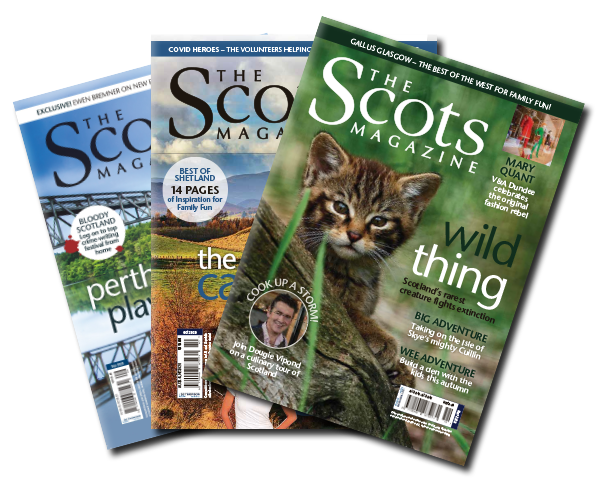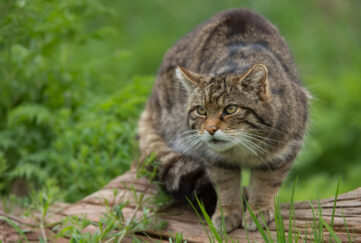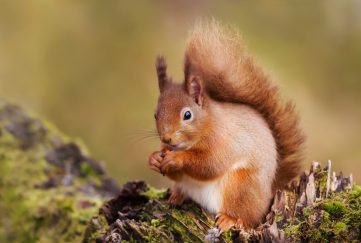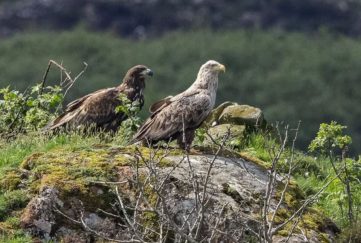Discover Sea Eagles In The East
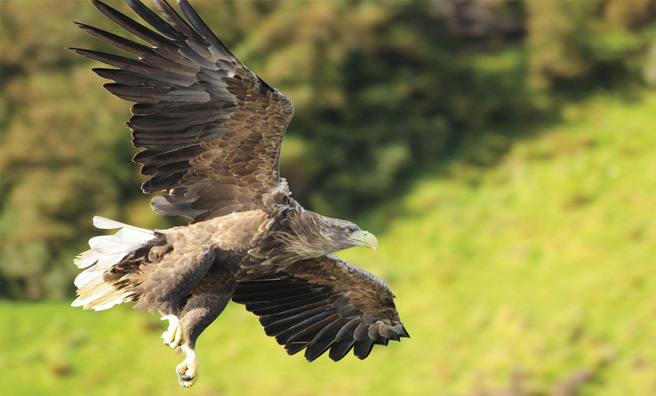
 Jim Crumley has an extraordinary encounter with a sea eagle in Fife
Jim Crumley has an extraordinary encounter with a sea eagle in Fife
A narrow hill road in North Fife, the car newly stowed on a verge by a drystane dyke, engine silenced, headlights doused.
The last hour of the early morning half-dark rushed into the open window while the cooling engine muttered to itself. I wanted to nullify the intrusion of my arrival before I headed out; to be at peace with nature when I went to work.
I closed my eyes and listened. Almost at once I heard soft wings – small soft wings. I opened my eyes. A wren. It was on a branch of a skinny little holly bush, about two yards away and at eye level. A wren at eye level is disconcerting. The eye is perfectly round and perfectly black and perfectly tiny. I say one eye because wrens look at you side-headed. You find yourself wondering if the eye you can’t see is watching something else.
The irony is potent. I am looking for sea eagles. I find a wren. In this landscape, the wren is the eagle’s fellow traveller, and that inscrutable little full-stop of an eye is as much nature as the eagle’s yellow glare.
The wren and I watched each other for perhaps a minute, which is a long stillness for a wakeful wren. What disturbed it was a blackbird’s arrival at the other end of the wren’s branch. The wren dived down into deeper cover; the blackbird protested at something beyond my reach and vanished in the opposite direction.
There are eagles in Fife, sea eagles, and recently
I had a tantalising glimpse of three of them
Eagles in Fife. I still find it hard to get my head round the idea. Here, of all places. I used to bring my bike over here from Dundee on the Fifies; Uncle Bert used to live just over the hill. The Fifies and Uncle Bert are long gone. And now there are eagles in Fife – sea eagles. Recently I had a tantalising glimpse of three of them cross that wedge of sky between hilltop and forest edge before I lost them in the gloaming.
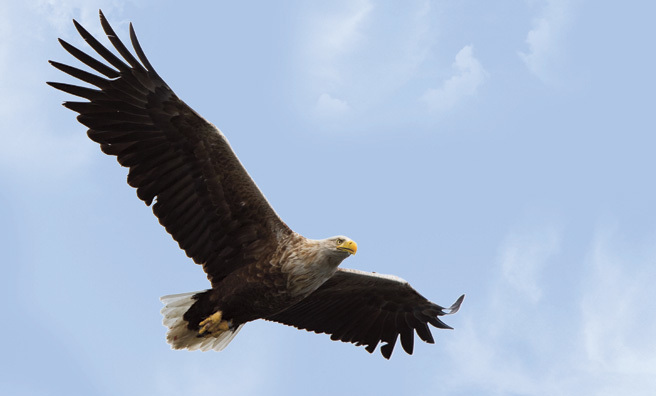
A sea eagle in flight(Pic: Alamy)
That same wedge of sky began to fill hopefully with pale yellow. The light spread south across the hilltop and behind the pines, then down the far side of the hill. There it lingered long enough for me to register the presence of a small horde of rabbits all across the lower slope. Surely the eagles would home in there as soon as the light brightened. If I were a sea eagle, I reasoned, the high pines were where I would have roosted, trees with an open outlook, and rabbits for breakfast. So I determinedly re-focussed binoculars on the trees and the hilltop and drifted them optimistically out into the wedge of sky from time to time.
I saw it as a disturbance of air, low and to my right
I felt rather than saw or heard the sea eagle. It seemed to manifest itself moments before I saw it as a disturbance of air, low and to my right. There was a bellowing crow almost in my ear, then a second crow not far above my head, both furiously on the move. I turned at the sound and whatever awareness that had preceded it, twisting awkwardly round my right shoulder. A sea eagle, twenty yards downhill, ten yards inside the field, two yards off the ground, and swatting the air with gulping wingbeats the size of fireside rugs.
The tail was startlingly white in so many shadows. The crows homed in on that tail from either flank as if it was a target being towed along by the eagle for the purpose. The nearer crow was close enough for me to hear the creak of its wings, the further one diving down, a yard behind the eagle and closing.
As Close As I’ll Ever Get
Then there was a moment of connection. My head-and-shoulders movement was more than enough to betray my presence to the tormented eagle. It looked upwards and left and made eye contact.
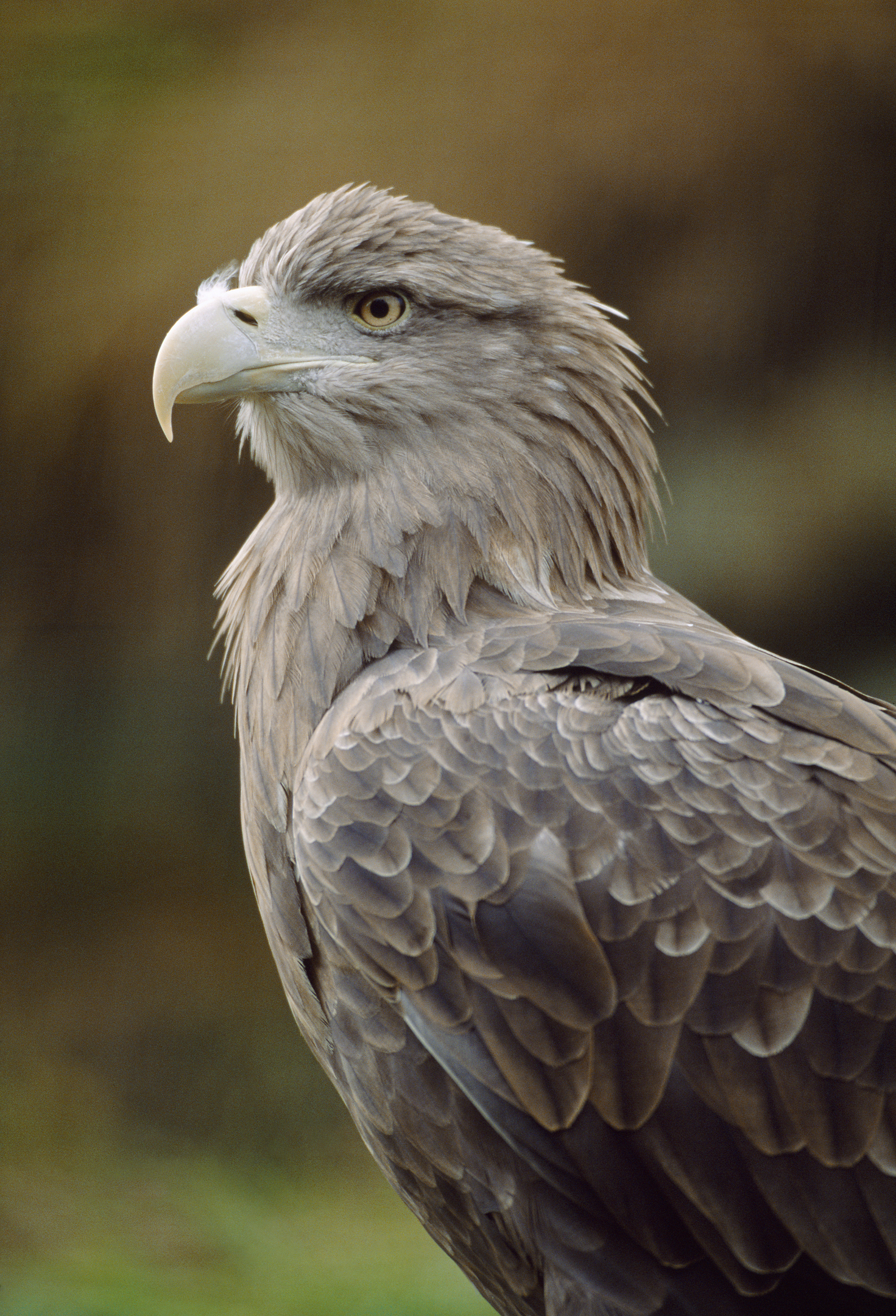
Close-up of a White-tailed Sea Eagle
I now have an image of that sea eagle pinned to the inside wall of my skull for my brain to look at whenever it needs one.
The eye – the one, side-headed eye like the wren – is pale yellow, its shade prefigured in that first dawn flush. It is darkly hooded. It sits high in the profile of the head, which is lightly mottled pale grey and fawn, and just astern of that massive yellow hooked slab of a beak.
Memory has fixed that eye just ahead of the “elbow” of the left wing at the moment the wing reaches the lowest, widest reach of the downstroke. But the bottom of the downstroke at close quarters and from slightly above reveals a bird cloaked in a corrugated drapery of up-curved feathers.
These folds of feathers are of such a size that they redefine the very word “feather” in your mind. No part of what you can see looks like a bird shape. The whole thing rather presents the form of a bluntly cornered and tilted triangle. The wing elbow at the apex, the tail feathers at the right corner and the primaries of one wingtip at the left corner. Only that eye, forehead and beak protrude beyond the smother of feathers.
Those crows are still having nightmares
The upswing begins, the head vanishes, the triangle collapses and the moment is done. In its place there is an articulate eagle, low and unhurried over the field with two crows in thankless pursuit. The eagle contrives a mid-air convulsion that flips the whole, improbably nimble mass on its back. Instantly, the crows are confronted not with a white tail to torment but with a raised pair of talons of such size that those crows are still having nightmares. It is enough. They wheel and climb back to the trees where they try to restore a semblance of dignity. The eagle reverses the convulsion and resumes its low-level flight which appears at first to have the rabbit warren as its destination.
Such is the joyous unpredictability of working eagles in a new landscape setting. We – eagle and eagle-watcher – are making it up as we go along, and then revising what we have made up almost as soon as it is made. I had made my best guesses based on my frail grasp of sea eagle logic. Based on the little I thought I knew, I had settled on a particular corner of a particular landscape, only to have a sea eagle ambush me from behind.
I watched it fly towards the rabbit field, but about two hundred yards short of the field it banked and climbed and perched high in the open edge of a small plantation of big conifers. Then it began to preen, with a settled-looking, I-may-be-some-time air. I scouted with the glasses all over the sky and in every corner of the land that was available to me from where I sat, but the preener in the tree was the only eagle in sight. So I decided while I waited to reconstruct the events that had just materialised behind my back.
The trees immediately beyond where I first saw the eagle were too awkwardly spaced and too thickly branched for such a huge bird to have flown through them – yet the eagle was surely too close to the trees, and too low, to have flown over them.
The sea eagle had astonished the crows as it astonished me
Two possibilities occurred to me. One was that the eagle had flown up the edge of the field and I, facing the other way, had not seen it. But the crows had only given voice at the very last minute when the eagle was already very close. I know from many years of watching golden eagles that crows are smart, sharp-eyed, noticing creatures. They will travel hundreds of yards to harass eagles, hurling abuse the whole way. It was clear that here the crows had travelled no distance at all to greet the sea eagle, and that could only mean that it had astonished them as it astonished me.
So the second possibility is this: the eagle was there all the time.
It was there, perched in the trees between the road and the field, facing across the field to the hill. Its head swinging round to glare at the intrusion represented by my car engine and headlights, relaxing again in the silence that followed when the sound and the lights died.
But then there was the blackbird alarm; alarmed at whatever it was I failed to see… an eagle?
The car door had closed, not loud, but worryingly conspicuous at that moment in that landscape. The sound would have been placed by the eagle precisely where the car engine had stopped. The eagle would have been perched in the trees, glaring at the place where I stepped beyond the fence into the field edge. As I walked uphill towards its very tree, adjusting its head position minutely and moment by moment as I came closer.
The eagle’s head had swung through 180º
By now the eagle’s head had swung 180º, and it was still perched in the trees when I sat. It decided I posed no threat, and that at least until daylight came, stillness would serve its cause best. When daylight did arrive the crows spotted the eagle and urged it on its way – but not, perhaps, until it flew.
It seemed to me to be extraordinary behaviour for an eagle. I had thought myself fairly well-versed on eagle behaviour. But then the eagle with which I am familiar is not this one.
Because a golden eagle would not be seen dead in Fife – not even North Fife.
You can read more of Jim Crumley’s Scottish wildlife columns online here, and each month in The Scots Magazine.
Subscribe to The Scots Magazine today for more from Jim Crumley >>
